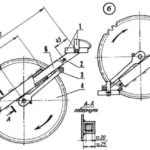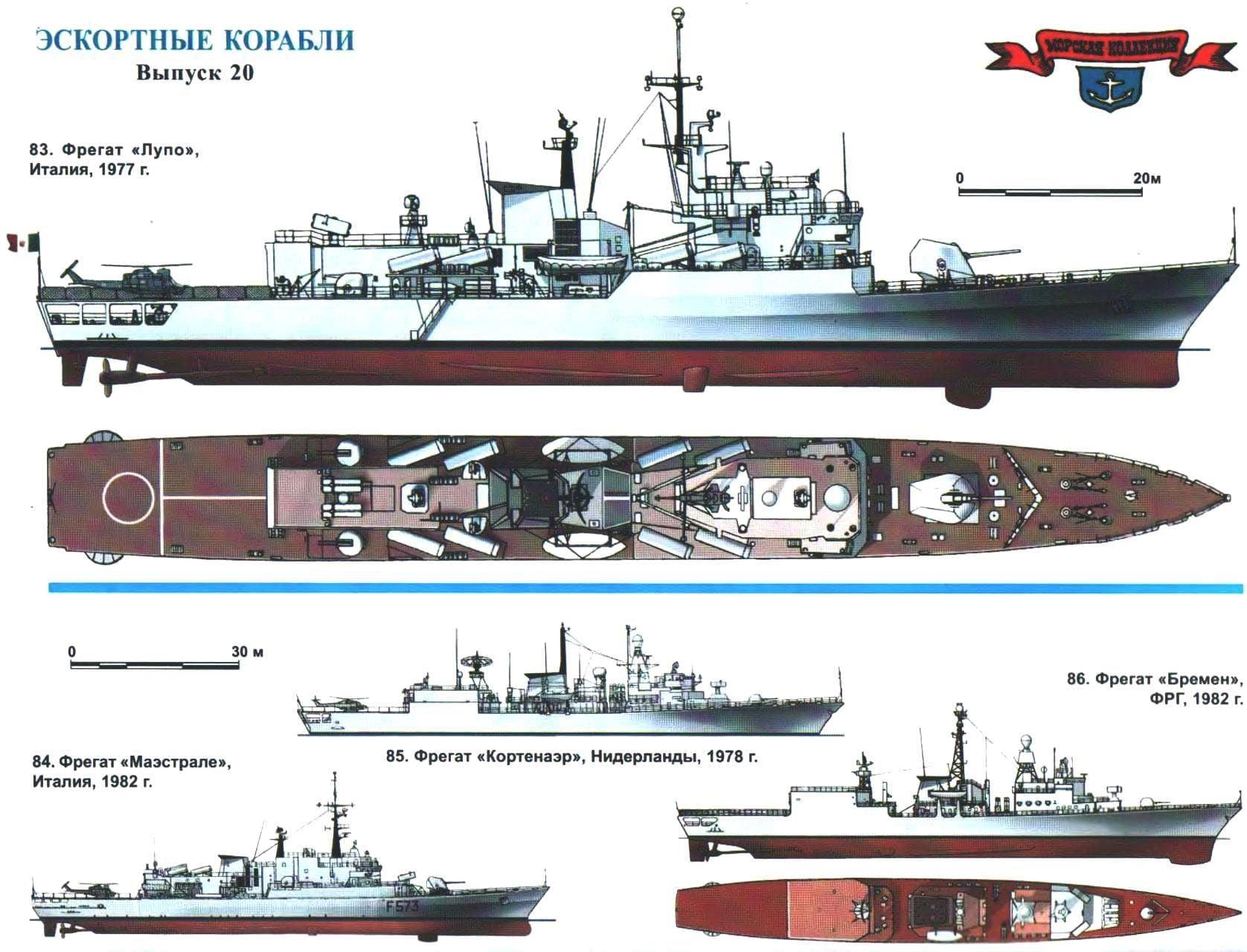 In early 70-ies of XX century views on the use of surface naval forces has changed significantly. In the West, only one country — the United States continued to rely on shock aircraft carrier connections. The European partners of the Americans within NATO to follow the example of Washington did not make sense: first, it was unaffordable, and secondly, their doctrine assumed that the main theatre of war the third world war will be the Mediterranean sea and the Atlantic. under the guise of coastal aviation.
In early 70-ies of XX century views on the use of surface naval forces has changed significantly. In the West, only one country — the United States continued to rely on shock aircraft carrier connections. The European partners of the Americans within NATO to follow the example of Washington did not make sense: first, it was unaffordable, and secondly, their doctrine assumed that the main theatre of war the third world war will be the Mediterranean sea and the Atlantic. under the guise of coastal aviation.
Hence the need for a relatively small versatile warships of the Maritime areas, able to solve wide range of tasks. Such requirements are best answered by missile frigates of the new generation — they have priority in the shipbuilding programmes of the NATO countries, It meant that the ships of this class have ceased to be an escort and turned into a multi-purpose. Respectively increased and their “rating” in the naval hierarchy: the frigates had actually replaced the destroyers, the ex before that, the largest surface units of most of the States of the West and the third world.
On the face of the new generation of frigates is strongly influenced by the fact that the “filling” of the military ships became increasingly difficult, and to develop its own even poor countries with a strong industrial base was unprofitable. Than to spend huge sums on research and project work, much better look to buy existing units and systems abroad — for example, in the United States. And the result was a paradoxical situation: warships, which were built in completely different countries — for example, in Germany, Italy or Japan — have become so similar that they can be considered almost twins. They carried the same weapons systems, electronic equipment, same energy, and had almost an identical concept of combat use. Alas, the national shipbuilding school, such as French, Italian, German — have sunk into oblivion. Really in the last three or four decades, their schools, there are only two: the Western and the Soviet. Today we will talk about the first one.
In the 1970s, the years of “cold war” was in full swing, and requirements for new frigates, NATO leaders were, of course, on the basis of imaginary “Communist threat”. If before Western navies feared Soviet submarines, now they have new potential enemies, modern jet aircraft and anti-ship missiles (ASM). Thus, the need arose to be placed on ships weapons, able to fight any enemy at sea, under water and in the air.
With the exception of England and France, continued to develop its own artillery and missile systems, the rest of the NATO countries decided to unify their naval armament on the basis of existing samples. The artillery of the main caliber — a good 127-mm and 76-mm automatic guns — were supplied by Italian company “OTO-Melara”. As air defense frigates was chosen by the American anti-aircraft missile complex “sea Sparrow” specially redesigned at a smaller size and received the designation “NATO sea Sparrow”. Also, the us was anti-submarine torpedoes. Of anti-ship missiles standard steel two systems — the French “Exocet” and the American “Harpoon”. (Though the Italians tried to market their own rocket “Otomat”, created jointly with the private French firm “Matra”, but the European partners in the North Atlantic bloc she is not attracted to). Orders for electronic equipment went mostly Dutch and American firms. From anti-submarine recettore refused; by the time it became clear that carrier-based helicopter is a more effective means of combating submarines. By the way, the helicopters were also standardized: most countries have adopted the Anglo-French “Linke”, and Italy and Greece — AV-212, manufactured by American license of Italian company “Augusta”.
The first frigate-the universal has become a new generation of Italian “Lupo” (“Wolf”), came into operation in 1977.
Despite its small size (its total displacement is only slightly exceeded 2500 tons), he got very powerful weapons that included eight containers RCC “Otomat”, anti-aircraft missile complex “Albatross” (an Italian variation on the theme of “sea Sparrow”), two three-pipe torpedo tubes, helicopter, one 127 mm gun mount and two coupled 40-mm gun as the main engines consisted of two gas turbine LM-2500 of the American company General electric and two diesel of his own company GMT. Power plant worked on two of the propeller controllable pitch. Body made of steel, superstructure — aluminium alloy.

83. The frigate “Lupo”, Italy, 1977
Built at the shipyard “Fincantieri”. The standard displacement of 2200 tons, full 2525 T. maximum Length of 113.2 m, beam 11,3 m, draft 3,7 m Power disalvatore-term installation of 60,000 HP, speed 35 knots. Armament: 8 RCC “Otomat”, 1×8 PU SAM “Albatross”, one 127 mm gun mount and two coupled 40-mm machine gun “Breda-Bofors”, three-pipe, two 324-mm torpedo tubes ASW, one helicopter. Only 1977 — 1992 built 18 units, including 6 for Venezuela and Peru for 4 (2 of them built in Peru Italian license).
84. The frigate “Maestre”, Italy, 1982
Built at the shipyard “Fincantieri”. The standard displacement of 2,500 tons, fully 3200 t Length overall the 122.7 m, a width of 12.9 m, draft 4.6 m. Power titelgestaltung installation 62 600 HP, speed 32 knots. Armament: 4 RCC “Otomat”, 1×8 PU SAM “Albatross”, one 127 mm gun mount and two coupled 40-mm machine gun “Breda-Bofors”, three-pipe, two 324-mm torpedo tubes ASW, 2 helicopters. Only in 1982 — 1985 built 8 units.
85. Frigate “Kortenaer”, the Netherlands, 1978
Built at the shipyard of KMB. The standard displacement of 3050 tons full 3630 T. maximum Length 130,5 m, width of 14.6 m, draft of 4.4 m. the Capacity of the gas turbine installation 70 400 HP, speed 30 knots. Armament: 8 RCC “Harpoon”, PU 1×8 SAM “NATO sea Sparrow”, one 76-mm gun mount and one semicolony 30-mm automatic “Fails”, paired two 324-mm torpedo tubes ASW, one helicopter. Only in 1978 — 1983 built 12 units.
86. The frigate “Bremen”, Germany, 1982
Built at the shipyard “Bremer Vulkan”. The standard displacement of 3100 tons, full 3800 T. maximum Length to 130.5 m, a width of 14,4 m, draft 4,5 m. Capacity titelgestaltung installation 51 600 HP, speed 30 knots. Armament: 8 RCC “Harpoon”, PU 1×8 SAM “NATO sea Sparrow”, 2×24 PU RAM SAMS, one 76mm gun mount and two 20-mm machine gun, paired two 324-mm torpedo the PLO, two helicopters. Only in 1982— 1990 built 8 units.
“Lupo” made a strong impression on specialists — so compact and yet so versatile heavily armed ships at that time did not exist. However, immediately revealed the shortcomings of the project, associated with the excessive density of the layout. Seaworthiness of the frigate proved to be acceptable to the Mediterranean sea, but is clearly insufficient for action in the Atlantic. Lack of space was forced to use storage sliding telescopic helicopter hangar, proved extremely inconvenient to use. Recognized unsuccessful and the location of the 40-mm guns — they had small angles of attack were too low, which led to their flooding by waves in stormy weather. It became evident that to accommodate such armament required a larger ship.
However, a series of frigates of the “Lupo”, in spite of their shortcomings, have been very significant. Became interested in the project of “third world” countries, and in addition to the four units for the Italian Navy six were built for Venezuela and four for Peru (the last two were constructed in South America with Italian assistance). Export frigates differed from the head “Lupo” by a rigid hangar is sliding, for which he had to pay a waiver of a mechanical system recharge SAM “Albatros” (left hand only). In addition, the Peruvian ships raised on one layer and 40-mm guns.
Finally, another four frigates of type “Lupo” in 1981, were ordered by Iraq. They were built without anti-submarine weapons and sonar (at the time potential opponents of Saddam Hussein in the Persian Gulf submarines were not). In fact, we do not understand why Iraq needed, these ships are likely only to maintain prestige. Perhaps, therefore, the financing of construction was carried out intermittently, and until 1990, they never entered into operation. And then to Baghdad, the UN imposed an embargo on the supply of weapons, and turned into unfinished frigates were generally irrelevant. Attempts to find them a buyer was not successful, but in 1992 they still got the Italian fleet. Thus, in the Mediterranean theatre were eight frigates of the “Lupo” instead of the planned four, but by the standards of the 1990s, they have not fully met the requirements for new ships the requirements.
By that time in the Italian Navy for about ten years served more advanced frigates of the “Maestrale”. In fact, they were a redesigned and enhanced version of the “Lupo”. However, certain changes were made in the technology of construction. Thus, the housing of each vehicle was collected from 14 sections, pre-fabricated in workshops. The construction of the sections in the closed premises has improved the quality of work and reduce the time spent hull on the slipway. The armament remained virtually the same; reducing the number of launchers ASM “Otomat” offset by the presence of two helicopters AB-212, which were now more capacious hangar.

87. The frigate “Descubierta”, Spain, 1978
Built at the shipyard “Basan” in Cartagena. The standard displacement of 1233 tons, full 1480 T. Length overall 88.8 m, width 10.4 m, draught 3.2 m. capacity of the diesel installation is 15 000 HP, speed 25 knots. Armament: 8 RCC “Harpoon”. PU 1×8 SAM “NATO sea Sparrow”, one 76-mm gun mount and two 40-mm machine gun, two three-pipe 324-mm torpedo tubes ASW. Only in 1978 — 1983 built 9 units, including 2 for Egypt and one to Morocco.
88. The frigate “Niels JUEL”, Denmark, 1980
Built at the shipyard in Alborg. The standard displacement of 1190 tons, full 1320 T. maximum Length 84 m, width 10.3 m draught 3.1 m Power diesel-gas-turbine plant 29 800 HP, speed 28 knots. Armament: 8 RCC “Harpoon”. PU 1×8 SAM “NATO sea Sparrow”, one 76-mm gun mount, one release gear. In 1980 all 1982 built 3 units.
Almost simultaneously with the Italians of the project “standard” frigate, NATO has developed in the Netherlands. In contrast to the “Lupo” Dutch”, Kortenaer” was also noticeably larger and the displacement consistent with the destroyers of the previous generation. It is possible to create a ship with more balanced performance and to avoid excessive use flammable aluminum alloys. Case “Kortenaer” is better divided into compartments (he had 15 watertight bulkheads is 13 “Lupo”); no satisfactory and seaworthiness. Very original was energy — pure gas turbine with two pairs of propulsion turbine and the afterburner of English manufacture. The composition of the weapons — close in time to meet the “Italians”, but instead of RCC “Otomat” used American missiles “Harpoon” instead of “Albatross” — “NATO sea Sparrow”, and the main caliber was limited to 76-mm art installation. In the hangar there was one helicopter Linc. Characteristic detail: the combat information management system SEWACO “Kortenaer” at a special communication channel was associated with similar systems of the ships of other NATO countries, which ensured the necessary coordination of actions within international forces.
Only the Dutch laid the 12 frigates of the “Kortenaer”; two of them are already in course of construction sold in Greece. They, by the way, the hangar was extended by 2 m, which allowed to place two Italian helicopter AB-212. Later the Greek fleet received four ships, two in 1997 — 1998 were transferred to the Dutch Navy of the United Arab Emirates. Getting rid of it is more combat-ready ships, a phenomenon, in General, is atypical. However, it allowed the Dutch to upload their shipyard new orders to create the next generation of frigates, considered among the best in the world.
Frigate “Kortenaer” was the inspiration of the West German ships of the “Bremen” commissioned in 1977 for replacement of the obsolete destroyers type Fletcher and frigates of the “köln”. The main difference between the “burdens” from “Dutch” is the more usual power plant, consisting of American gas turbine LM-2500 and two 20-cylinder V-shaped diesel engines by German firm MTU. In addition, in the hangar could accommodate two helicopters Linc, a 30-mm gun “the shot” the Germans have replaced the two SAM-defense RAM (by the way, considered in the West the most effective among all its counterparts). Electronic equipment remained mainly Dutch.
Similar in characteristics and even look the frigates types”, Kortenaer” and “Bremen” in the early 1980-ies was considered the most successful multi-purpose surface ships in the Navy of NATO. At the same time, their cost does not fit into the budgets of less affluent partners in the North Atlantic Alliance. Therefore, in a number of countries decided to build the frigates for their own projects — smaller and cheaper, but also meet NATO standards.
The specific interest of the Belgian frigates type “Vilingen”. Due to the failure of the helicopter of the Belgian designers have designed well-armed ship, very small but capable of functioning not only in the coastal zone, but also in the Atlantic. Its powerplant consisted of one English gas turbines and two diesel engines manufactured in Belgium, who worked on two of the propeller. Missiles (“Exocet”, “NATO sea Sparrow”) and radar equipment is standard, but the money SQUARE is not NATO, and typically French (375-mm rocket mortars and two single-tube 533-mm torpedo tubes). French artillery of the main caliber (100-mm universal gun on the tank).
Looks even more compact than the other project — the Spanish frigate “Descubierta”. Although Spain in the 1970-ies and was not a member of NATO, its armed forces in General and Navy in particular Madrid was equipped with an eye to Western European countries. So, the “Descubierta” set the same set of weapons. SAM “NATO sea Sparrow”, 76-mm and 40-mm automatic artillery systems, 324-mm torpedo tubes, and after commissioning — ASM “Harpoon”. No helicopter is required to strengthen the arms of the PLO, so the bow has additionally placed a double-barreled 375-mm rocket mortar of the Swedish company “Bo-fors”. Power plant is a cheaper, consisting of four diesel engines, working through two gears on the propeller shaft. Only the Spanish built nine frigates of the “Descubierta”, including three for export (Egypt and Morocco).
But the record of the combination of miniature size and very powerful weapons with relatively decent seaworthiness does not belong to the Spanish and Danish ship. However, it is quite an achievement of the British, as the project of the frigate “Niels JUEL” for the Navy of Denmark has developed one of private British firms. At full displacement of 1320 t “Niels JUEL” had a combined diesel-gas turbine power plant (one turbine LM-2500 diesel and MTU) again, a standard set of weapons — with the exception of the helicopter. However, in the course of construction due to overload eventuated had to refuse the setting of anti-submarine torpedo tubes — in the end from the means of combating submarines on the frigate left only the aft ejector depth charges. Of course, for ocean spaces this ship in fact was not a frigate, and a Corvette, were not good, but restricted Maritime theatres could solve a wide range of tasks, especially in interaction with other ships and air base.
S. BALAKIN
Recommend to read
 EASY PRESERVING
EASY PRESERVING
Preparation for the winter vegetables, fruits and berries in many cases, connected with great inconvenience due to the imperfections of technology and primitiveness kitchen appliances... THE BIKE CHANGES SHAPE
THE BIKE CHANGES SHAPE
Not the first time the editors publish original contributions on the improvement of the Bicycle, the author of which is an inventor, engineer Vladimir Gavrilov from the village of...
 In early 70-ies of XX century views on the use of surface naval forces has changed significantly. In the West, only one country — the United States continued to rely on shock aircraft carrier connections. The European partners of the Americans within NATO to follow the example of Washington did not make sense: first, it was unaffordable, and secondly, their doctrine assumed that the main theatre of war the third world war will be the Mediterranean sea and the Atlantic. under the guise of coastal aviation.
In early 70-ies of XX century views on the use of surface naval forces has changed significantly. In the West, only one country — the United States continued to rely on shock aircraft carrier connections. The European partners of the Americans within NATO to follow the example of Washington did not make sense: first, it was unaffordable, and secondly, their doctrine assumed that the main theatre of war the third world war will be the Mediterranean sea and the Atlantic. under the guise of coastal aviation.





